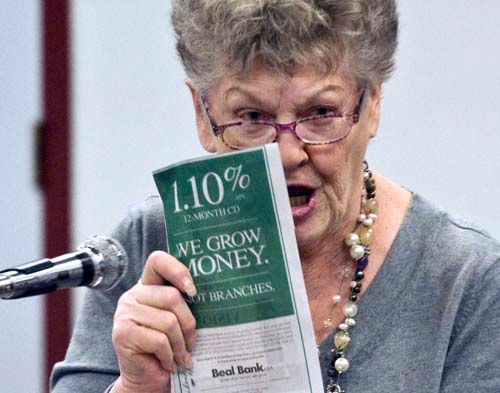NV Energy rate request yields consumer rage



Electric ratepayers are mad as hell.
That was the message Tuesday as the Public Utilities Commission of Nevada held two consumer sessions at Cashman Convention Center. The sessions gathered consumer comment on an 11.5 percent rate increase power utility NV Energy has requested.
"I just don’t understand how this could even be considered," said ratepayer Penny Hess, to a panel that included two NV Energy executives. "Don’t you people take any of us into consideration? I mean, what’s wrong with you? We’re just people who are trying to make it out here. You people need to get a grip."
About 50 people attended the 1 p.m. session. Roughly a quarter of them were with NV Energy, the commission and the Bureau of Consumer Protection. Around 15 people addressed the commission. A 6 p.m. session drew about 20 consumers.
State law requires the utility to file general rate cases every three years. General rates cover operating costs such as maintenance, labor, depreciation, taxes, interest and return on equity.
The utility wants an 11.5 percent general rate increase, which would push the average monthly bill from $140 to $147. The company says it needs the hike, which would raise $249 million in additional annual revenue on a current revenue base of $2.2 billion, to pay for expansion of the Harry Allen generating station north of Las Vegas, and to raise its allowable investor return from 10.5 percent to 11.25 percent.
State consumer advocate Eric Witkoski says NV Energy could get by with a revenue increase of $88 million a year. He’s urged the commission to lower the rate of return from 10.5 percent to 9.7 percent, and said cutting operations and maintenance payrolls by 4.4 percent would save ratepayers on their bills.
The commission will decide the case in December. New rates take effect Jan. 1.
After brief presentations Tuesday from NV Energy executives and attorneys with the commission and the Bureau of Consumer Protection, consumers had their say.
Ratepayer Dan Hickey said he was "astounded" at the 11.25 percent requested return.
"Can I get that from NV Energy? Can I just give you $100,000 and get that from you? That would be nice," Hickey said. "But I can’t. And I don’t think it’s fair for you to get that from me."
Consumer Kay Rodriguez also blasted the return request, noting that money market accounts pay 1 percent these days, while U.S. Treasurys pay 2 percent. Microsoft dividends run 2.4 percent.
"Anything over what you can get at the bank and from government bonds is unfair, unjust and uncalled for," Rodriguez said. "The money you get a higher rate on is for risk. What is the risk for (NV Energy), when they have everybody on the hook?"
A return of 6 percent would be a "high rate in today’s market," Rodriguez said.
Barry Gold, AARP Nevada’s director of government relations, said analysis from the Bureau of Consumer Protection shows a return of below 10 percent would preserve NV Energy’s financial integrity and is fair in a down economy.
"The proposed rate increase is significant, and will hit all Nevadans at a time when the economy of the state is still struggling to recover," Gold said. "AARP understands an essential service cannot be provided at a loss, but the rate of return on investment for utilities should be fair and reasonable, and not a dime more."
And ratepayer Jonathan Friedrich took issue with NV Energy’s executive salaries. He drew boos from the crowd as he reeled off a list that included Chief Executive Michael Yackira’s $5.3 million annual pay and Chief Financial Officer Dilek Samil’s $2.5 million yearly pay.
"I understand why they need a rate increase," Friedrich said. "Folks, the numbers speak for themselves. Why should we, the ratepayers, be saddled with corporate greed?"
Tuesday’s crowd was considerably lighter than 2009’s turnout of more than 100 people and more than 40 speakers. The company requested a rate increase of 13.6 percent that year.
The commission rarely grants NV Energy its entire request. In its last general rate case in 2009, the company requested increased revenue of $311 million, but got $218 million. In 2006, the utility asked the commission to boost its allowed maximum return to 11.4 percent, but got permission for 10.7 percent.
To see filings in the case, visit the commission’s website at puc.nv.gov. Go to "Docket Info" on the left, click on it and select "Electric Dockets." The rate case is Docket No. 11-06006. The commission has consolidated Docket No. 11-06007, which involves depreciation expenses associated with utility plant assets, and Docket No. 11-6008, which deals with planning costs for the company’s canceled Ely Energy Center, into hearings for the general rate case.
Hearings continue through early November, but consumers are allowed to testify only at consumer sessions.
Contact reporter Jennifer Robison at jrobison@reviewjournal.com or 702-380-4512.












